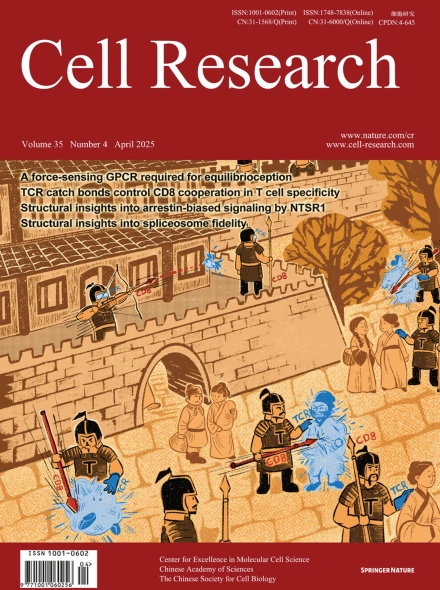
Advanced Search
Submit Manuscript
Advanced Search
Submit Manuscript
Volume 35, No 4, Apr 2025
ISSN: 1001-0602
EISSN: 1748-7838 2018
impact factor 17.848*
(Clarivate Analytics, 2019)
Volume 35 Issue 4, April 2025: 243-264 |
A force-sensitive adhesion GPCR is required for equilibrioception
Zhao Yang1,† , Shu-Hua Zhou1,2,3,† , Qi-Yue Zhang1,† , Zhi-Chen Song1,3,† , Wen-Wen Liu4,† , Yu Sun5,† , Ming-Wei Wang6,7,† , Xiao-Long Fu8 , Kong-Kai Zhu6 , Ying Guan7 , Jie-Yu Qi2 , Xiao-Hui Wang5 , Yu-Nan Sun9 , Yan Lu1 , Yu-Qi Ping8 , Yue-Tong Xi1 , Zhen-Xiao Teng8 , Lei Xu4 , Peng Xiao1,6 , Zhi-Gang Xu10 , Wei Xiong11 , Wei Qin12 , Wei Yang13,* , Fan Yi14,* , Ren-Jie Chai2,* , Xiao Yu3,* , Jin-Peng Sun1,6,9
1NHC Key Laboratory of Otorhinolaryngology, Qilu Hospital of Shandong University, and New Cornerstone Science Laboratory, Department of Biochemistry and Molecular Biology, School of Basic Medical Sciences, Cheeloo College of Medicine, Shandong University, Jinan, Shandong, ChinaEquilibrioception (sensing of balance) is essential for mammals to perceive and navigate the three-dimensional world. A rapid mechanoelectrical transduction (MET) response in vestibular hair cells is crucial for detecting position and motion. Here, we identify the G protein-coupled receptor (GPCR) LPHN2/ADGRL2, expressed on the apical membrane of utricular hair cells, as essential for maintaining normal balance. Loss of LPHN2 specifically in hair cells impaired both balance behavior and the MET response in mice. Functional analyses using hair-cell-specific Lphn2-knockout mice and an LPHN2-specific inhibitor suggest that LPHN2 regulates tip-link-independent MET currents at the apical surface of utricular hair cells. Mechanistic studies in a heterologous system show that LPHN2 converts force stimuli into increased open probability of transmembrane channel-like protein 1 (TMC1). LPHN2-mediated force sensation triggers glutamate release and calcium signaling in utricular hair cells. Importantly, reintroducing LPHN2 into the hair cells of Lphn2-deficient mice restores vestibular function and MET response. Our data reveal that a mechanosensitive GPCR is required for equilibrioception.
https://doi.org/10.1038/s41422-025-01075-x